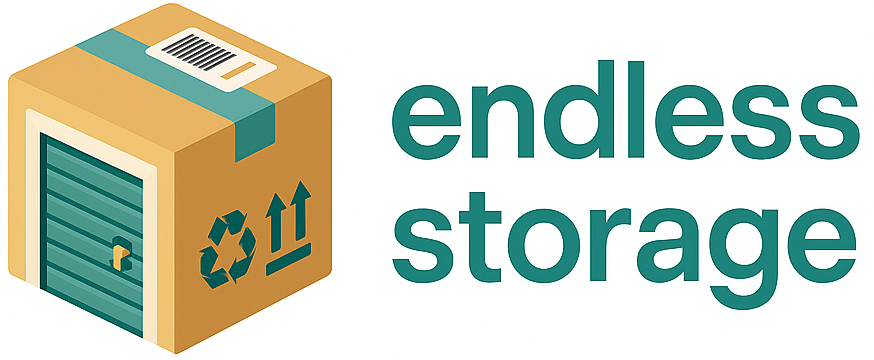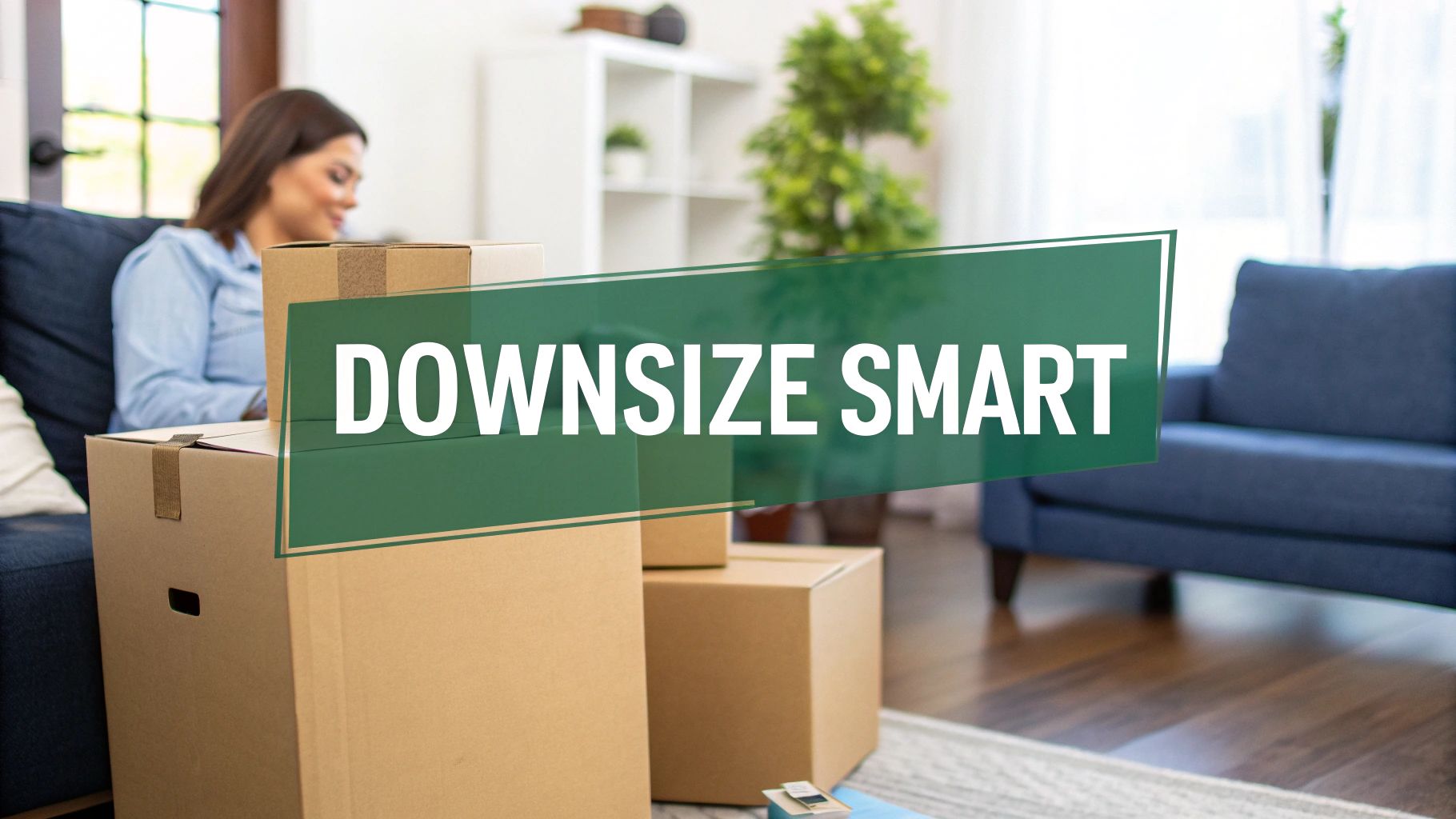Successfully downsizing your home means shifting your mindset. You're not just getting rid of things; you're intentionally choosing what fits the life you want to live. It's a process that blends a bit of practical sorting with a clear vision for your new, smaller space. Think of it as making smart, deliberate choices now to enjoy more freedom down the road.
Why Downsizing Is More Than Just Decluttering
The choice to downsize often comes from a much deeper place than just wanting a tidier house. It's a powerful, proactive decision to reshape your life, get a handle on your finances, and carve out more mental and physical space for what actually matters to you.
This isn't your average weekend closet cleanout. It’s a strategic move toward living more intentionally. For a lot of people, it’s a direct response to a world that feels a bit unsteady. Economic pressures and changing priorities are huge drivers behind this trend. In fact, data for 2025 shows a big jump in homeowners moving to smaller properties to shore up their finances. Downsizing has become a practical way to tap into home equity and cut down on financial stress, a strategy that’s particularly popular with those heading toward retirement or feeling the pinch.
Redefining Your Relationship with Possessions
At its heart, downsizing makes you take a hard look at your relationship with your stuff. You start asking much deeper questions than just, "Where am I going to put this?" You find yourself wondering:
- Does this thing actually support the life I want to have?
- Is it adding real value, or is it just taking up room?
- Am I keeping this out of habit, guilt, or because I truly love it?
Answering those questions with brutal honesty is the real first step toward freedom from clutter. It’s a surprisingly liberating process that shifts your focus from just having things to truly appreciating them.
The goal isn’t to simply own less stuff. It’s to make room for more life, more experiences, and a lot more peace of mind. When you let go of the excess, you’re creating a home that’s a true reflection of what you value most.
The Financial and Personal Payoffs
The rewards go way beyond having fewer things to dust. Downsizing can seriously ease financial pressure by slashing your mortgage, utility bills, property taxes, and maintenance costs. All that newfound breathing room in your budget can go toward travel, hobbies, savings—or just working a little less.
On a personal level, the benefits are just as huge. A simplified, uncluttered environment can lead to less anxiety and a clearer head. The whole journey of letting go also builds resilience and hones your decision-making skills, empowering you to live more deliberately. By embracing this change, you aren’t losing anything important. You’re gaining control and setting the stage for a more fulfilling, clutter-free future.
If you're feeling inspired to get going, our guide on clutter-free living tips is the perfect place to start.
Creating Your Downsizing Game Plan
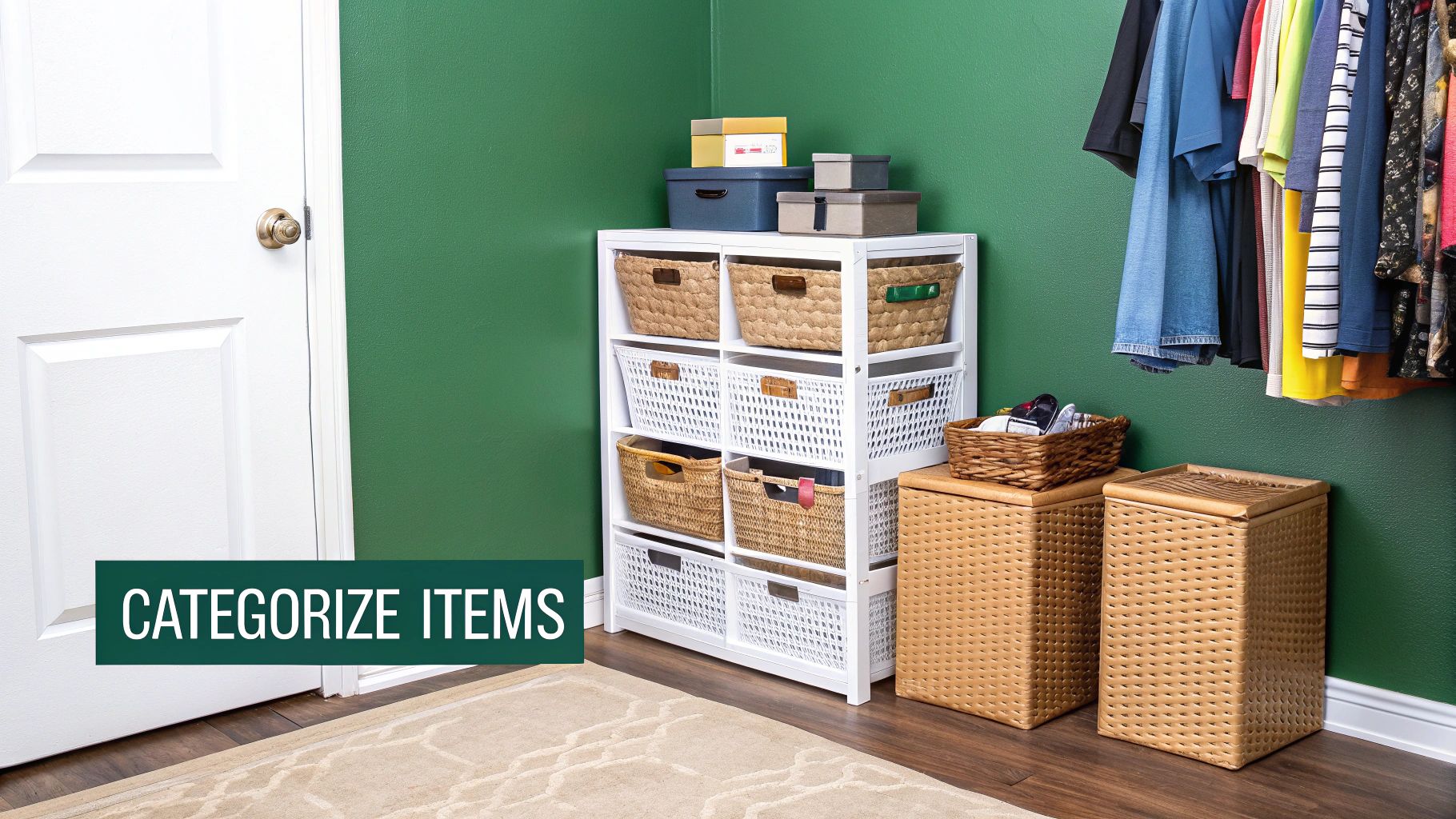 A good downsizing plan doesn't start with a mad dash through the house with a trash bag. Trust me on this one. It actually begins with a clear, intentional vision for what comes next. This prep work is your foundation, and it’s what will keep you going when the process feels like too much to handle.
A good downsizing plan doesn't start with a mad dash through the house with a trash bag. Trust me on this one. It actually begins with a clear, intentional vision for what comes next. This prep work is your foundation, and it’s what will keep you going when the process feels like too much to handle.
Before you even think about touching a single item, take a moment to figure out your personal "why." What's the real reason you're doing this? Is it to save money, spend less time on house chores, or finally have the freedom to travel more? This motivation is your anchor—the reason you’ll turn to when you’re wrestling with letting go of something sentimental that just won't fit into your new life.
A key part of building your game plan is learning how to set effective goals you can stick with. This gives your vague idea of "downsizing" a concrete, actionable structure.
Visualizing Your Destination
Instead of getting bogged down by what you're leaving behind, focus on where you're headed. I call this destination-driven decluttering, and it's a game-changer. Close your eyes and really imagine your new, smaller space.
- What’s the vibe? Do you want it to feel open and calm, or energetic and cozy?
- What will you actually do there? Host intimate dinners? Finally have a dedicated corner for your hobbies?
- Which of your current belongings are essential to support that specific vision?
This visualization trick reframes the entire process. You’re not just getting rid of stuff; you’re actively curating the perfect collection of items for the lifestyle you want to live. It’s a proactive way of thinking that cuts down on decision fatigue and makes every choice simpler. Your future home becomes the ultimate filter.
The question shifts from "Can I get rid of this?" to a much more powerful one: "Does this item belong in my future?" That small change in perspective makes all the difference when you're deciding how to downsize your belongings.
Setting a Realistic Timeline
Look, downsizing is a marathon, not a sprint. Trying to do it all at once is the fastest way to burn out. That's why setting an achievable timeline is so important.
Break the massive project into smaller, more manageable chunks. Maybe you tackle one room a month or dedicate one weekend to a specific category, like books or clothes. This approach creates steady progress and builds momentum without completely taking over your life.
This is a path many are walking. A Knight Frank study, for instance, noted a huge spike in downsizing interest, with the number of people looking to move into smaller homes jumping by about one-third in just one year.
By pinning down your motivation, visualizing your destination, and creating a practical schedule, you turn what feels like a monumental task into an exciting, forward-looking project. For an even deeper dive into this planning phase, our guide on how to downsize before moving has plenty more strategies to get you started.
A Practical Room-By-Room Decluttering Strategy
The secret is to create a simple, repeatable system. Before you even touch a single item, grab four boxes and label them clearly: Keep, Donate, Sell, and Discard. This simple framework takes the indecision out of the process, helping you make quick, confident choices. Don't second-guess yourself; just pick a box for everything you touch.
Conquering High-Impact Zones First
Starting with a high-traffic area like the kitchen is a fantastic way to build momentum. This space is often a goldmine of single-use gadgets, duplicate utensils, and expired spices that are easy to let go of. Just pull everything out of one cabinet at a time.
As you hold each item—that avocado slicer you used once, the third set of measuring cups—ask yourself one direct question: "Does this actually support the life I want to live in my new home?" Being honest about your real habits, not your aspirational ones, will help you clear out an incredible amount of stuff.
The closet is another high-impact zone. I've seen it countless times: most people wear only 20% of their clothes 80% of the time.
When you're sorting your wardrobe, it’s not just about what fits. The real question is, "Does this make me feel confident and happy right now?" If the answer is a hesitant "maybe" or a flat-out "no," it's time to let it go.
This straightforward process helps you gather your items, sort them with real purpose, and then beautifully organize what's left.
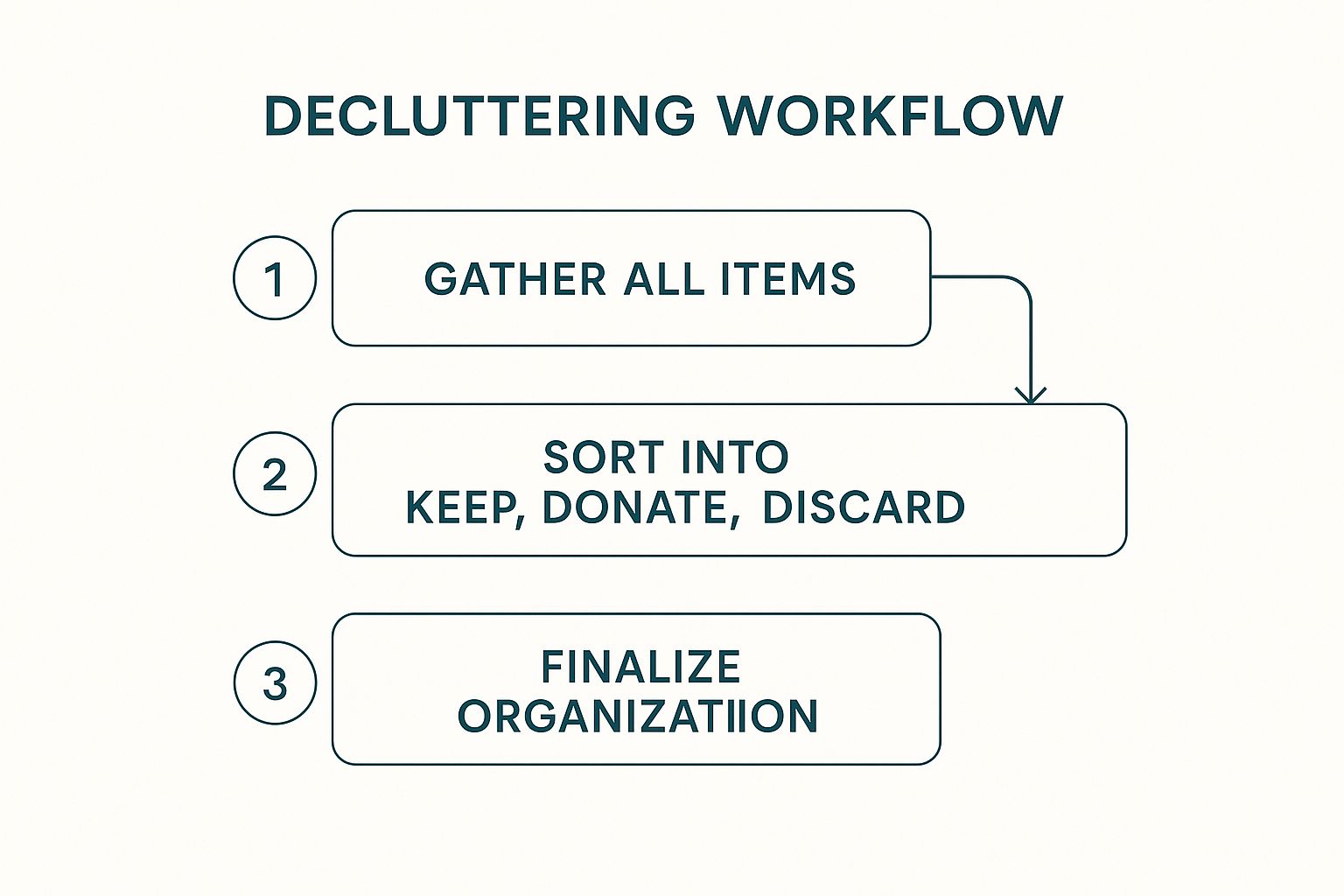
As you can see, that structured sorting phase is the critical bridge between simply gathering your things and ending up with a truly organized, finalized space.
Tackle Your Storage and Sentimental Spaces
Let's be real: garages and attics often become graveyards for things we just don't know what to do with. For these areas, you need to be a little ruthless. That sports equipment from a long-forgotten hobby, the collection of old paint cans, the boxes labeled "misc."—they all need a firm decision.
Here's my rule of thumb: If you haven't used it in over a year and it doesn't hold any deep sentimental value, it’s probably not worth the cost and effort to move it.
Finally, you have the bedroom, a space that absolutely needs to feel tranquil. Sorting through personal items here can be emotionally tough, but it's essential for creating a peaceful retreat in your new, smaller home.
For more targeted advice on this vital room, check out our step-by-step guide to declutter your bedroom for peaceful sleep.
This room-by-room strategy completely changes the game. Instead of facing an insurmountable mountain of stuff, you’re tackling a series of distinct, achievable projects. Every sorted drawer and cleared-out closet is a small win that fuels you for the next, making the whole process feel not just possible, but genuinely empowering.
Navigating the Emotions of Letting Go

Let's be honest: the physical act of sorting through your stuff is often the easy part. The real challenge comes from the wave of emotions that hits you when you start downsizing. You're not just handling objects; you're sifting through memories, nostalgia, and sometimes, a surprising amount of guilt.
This part of the journey is completely normal. In fact, acknowledging the powerful connection we have to our things is the first step toward making clear-headed decisions. That chipped mug from a college roommate or a box of your kid's artwork isn't just "stuff"—it represents a time, a feeling, or a person you cherish.
This is especially true for anyone who has spent decades in one home. One study found that for many older adults, downsizing was a massive lifestyle shift that started long before any boxes were packed. Participants had often lived in their homes for an average of 20 years, making the process of re-evaluating their possessions a deeply personal and emotional experience.
From Loss to Liberation
It's so easy to see downsizing as an experience of loss. You're "getting rid of" things you once loved. But what if you could flip the script? Instead of dwelling on what you're losing, try to focus on everything you stand to gain.
- More Space: Not just physical room to breathe, but mental space, too—free from the weight of clutter.
- More Freedom: Less to clean, less to manage, and more time and energy for what truly matters.
- More Peace: A calm, organized home has a direct, positive impact on your well-being.
This shift in perspective is a game-changer. You aren't erasing your memories; you're simply choosing a lighter, more intentional way to honor them while creating a home that serves you now and in the future.
Practical Ways to Preserve Memories
Letting go of a physical item doesn't mean the memory disappears with it. Here are a few strategies I’ve seen work wonders for preserving what’s important without keeping all the physical baggage.
Create a Digital Scrapbook: Before you sell or donate sentimental items, take high-quality photos. Organize them into a digital album or even get a physical photo book printed. This way, you can flip through the memories anytime without sacrificing an inch of closet space.
Keep a Single, Meaningful Piece: Do you really need all twenty of your grandmother’s teacups? Probably not. Pick the one that’s the most beautiful or holds the strongest memory. Display it proudly as a tribute to the entire collection and the person who gave it to you.
Decision-Making Framework for Sentimental Items
Making objective decisions about emotionally charged items is tough. I've found that using a simple framework can help remove some of the guesswork and guilt.
This table is designed to guide you through a more logical thought process when you feel stuck.
By asking targeted questions, you can honor the memory without being held captive by the object itself.
To help process the complex feelings that come up, exploring the benefits of journaling can be an incredibly useful tool for reflection and clarity. For more in-depth strategies, check out our guide on pro methods to declutter your home for good.
Smart Storage and Organization for Smaller Spaces
Okay, you've sorted through your belongings—now for the fun part. The next challenge is making everything fit beautifully into your new, smaller home. This isn't about cramming things into closets and hoping for the best; it's about smart organization that makes your space feel open, functional, and intentional. Think of it as the final, rewarding step in learning how to downsize your belongings effectively.
The key is to start thinking vertically instead of horizontally. In a smaller home, floor space is gold, but most people don't use their wall space nearly enough. Installing tall, narrow bookshelves or floating shelves does wonders. It draws the eye upward, creating an illusion of height while giving you a spot for books, decor, and bins. You’re not just storing items; you’re making the whole room feel bigger.
Make Your Furniture Work Harder
In a downsized home, every single piece of furniture needs to earn its keep. Single-use items are a luxury you can probably no longer afford. The trick is to focus on multi-functional furniture that serves at least two purposes.
- Storage Ottomans: These are absolute champions for hiding away blankets, remote controls, or board games while also serving as extra seating or a coffee table.
- Beds with Drawers: A bed frame with built-in drawers underneath can completely eliminate the need for a bulky dresser, freeing up a surprising amount of floor space.
- Extendable Dining Tables: Having a small table for daily use that can expand to accommodate guests is a brilliant way to stay flexible without sacrificing precious everyday space.
When your furniture actively contributes to a clutter-free life, it stops being just something that takes up room.
By choosing furniture that doubles as storage, you’re essentially adding hidden closets all over your home. It’s the single most effective strategy for maintaining a tidy, organized space without feeling like you’re living in a storage unit.
Digitize and Go Paperless
Let's be honest: physical documents, photos, and old media are some of the biggest space hogs out there. A single filing cabinet can take up a shocking amount of visual and physical real estate. The clear solution? Digitize as much as you possibly can.
Invest in a decent scanner to create digital copies of important documents, old photographs, and sentimental paperwork. Once everything is scanned and safely backed up to a cloud service, you can shred the vast majority of the originals. I've seen this one project clear out several boxes worth of clutter, freeing up drawers and closets for things you actually use.
Flexible Storage for In-Between Items
So, what about those items you need, but not right now? I'm talking about seasonal clothing, holiday decorations, or sports equipment. Keeping these things in your main living space just creates unnecessary clutter. This is where a flexible, off-site storage solution becomes a total lifesaver.
Services that offer box-by-box storage are perfect for this. You can keep those occasional-use items safe and out of the way without renting a big, traditional storage unit. When winter rolls around, you can simply have your box of sweaters returned, and send it back when you’re done. This strategy keeps your home beautifully uncluttered while ensuring you still have access to everything you own. For more ideas on maximizing your square footage, our guide on apartment storage solutions offers even more clever tips.
Frequently Asked Questions About Downsizing
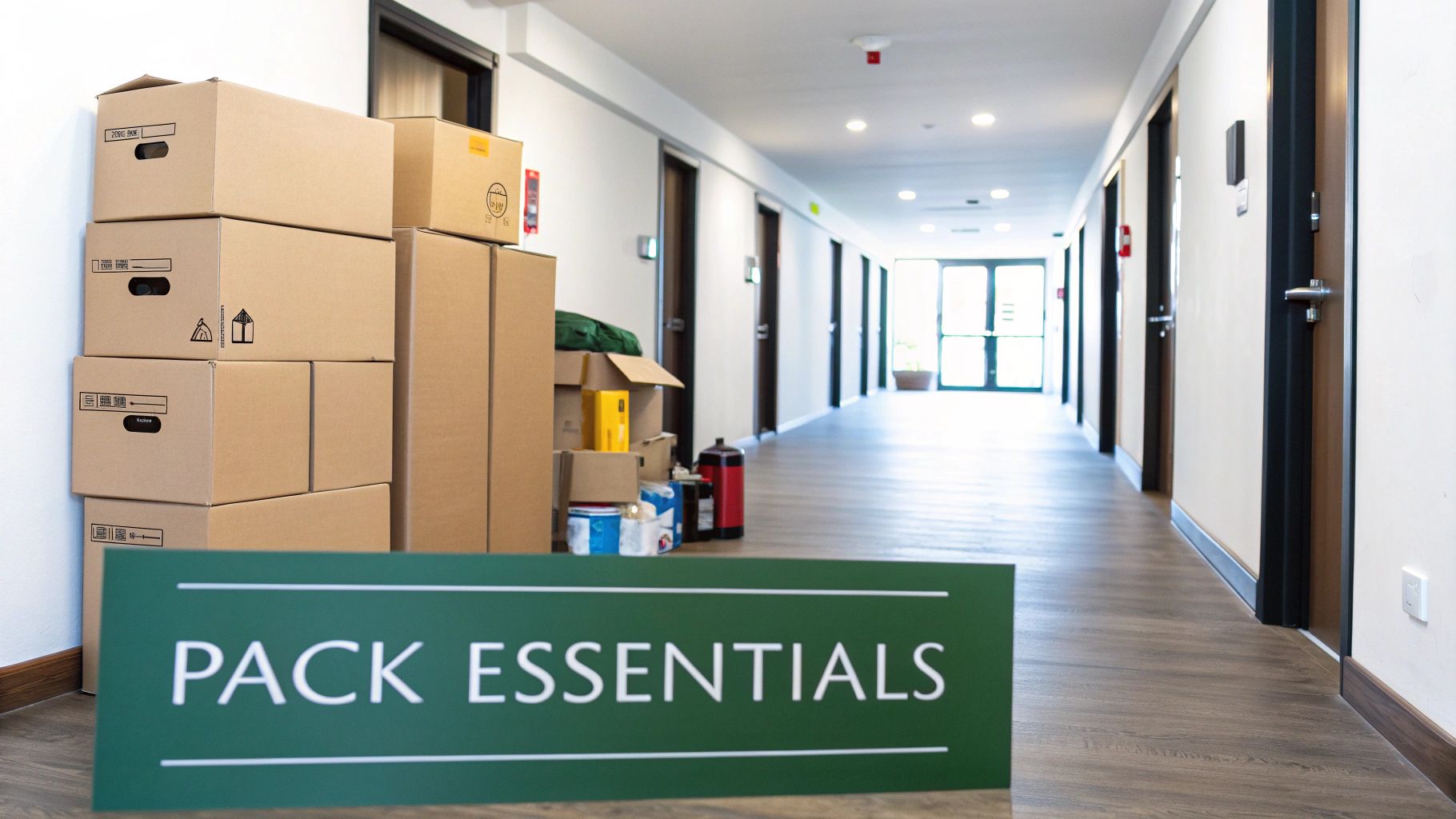 Even with the best plan in hand, you're bound to hit a few snags or second-guess yourself during a big downsize. That’s completely normal. Let’s tackle some of the most common hurdles I see people face, so you can move forward with confidence.
Even with the best plan in hand, you're bound to hit a few snags or second-guess yourself during a big downsize. That’s completely normal. Let’s tackle some of the most common hurdles I see people face, so you can move forward with confidence.
How Do I Handle Unwanted Gifts?
This one’s a classic, and it’s always wrapped in a layer of guilt. The trick is to mentally separate the gift from the giver. An item isn't the relationship itself, and your home shouldn't be a museum of every present you’ve ever received. Your goal is a space filled with things you actually love and use.
I always suggest this: thank the item for the joy it brought when you first got it, and then give yourself permission to let it go. You could re-gift it to someone who'll genuinely use it or donate it to a good cause. Remember, the act of giving was completed the moment you received it. You’re under no obligation to keep it forever, especially when it stands in the way of a simpler life.
What if I Get Rid of Something and Regret It?
The fear of "donator's remorse" can be paralyzing, but honestly, it’s usually more of a fear than a reality. If you take your time and sort thoughtfully, you’ll find you rarely miss the things you part with. And for most items, they’re easily replaceable if a real need ever pops up down the road.
It’s important to remember that you are letting go of physical objects, not the memories associated with them. Your memories remain, and you are gaining a calmer, more organized living space in return.
If you do find yourself regretting a decision, use it as a learning experience. Ask yourself why you miss that specific item. Was it truly useful, or are you just feeling the emotional shift that comes with change? Answering that question will only help you make better choices as you continue.
How Can I Get My Family on Board?
Downsizing is almost never a solo mission. Getting a reluctant partner or kids on board takes a bit of empathy and a lot of teamwork. Instead of just handing down orders, frame the conversation around the benefits you’ll all share.
- Focus on the "Why": Talk about what you’ll gain together—more financial freedom, less time spent cleaning, or more weekends for fun activities.
- Make It a Team Effort: Give everyone a real say in the process. Let them choose what's most important to them within the new space constraints.
- Start Small: Tackle a neutral zone first, like the linen closet or pantry. Seeing the quick, positive results can build momentum and get everyone excited.
When your family feels heard and can see the vision for a better lifestyle, they’re much more likely to jump in and help. You're not just decluttering; you're building a shared future.
Feeling overwhelmed by seasonal items or keepsakes you love but don't have space for? Endless Storage offers a perfect solution. We provide hassle-free, box-by-box storage, allowing you to keep what matters without cluttering your home. Learn more about our convenient storage options at https://www.endless-storage.com.
Frequently Asked Questions
Unveiling the Secrets to Effortless Storage
Endless Storage is available nationwide. You pick a plan, tell us where to pickup, and we'll send a UPS van to collect, whichever state you're in.
Your shipping label will be sent to your email within a few minutes, if not instantaneously. It can also be accessed through your customer profile.
Your box will be shipped to one of our climate controlled self storage facilities in our closest self storage facility. Our manager will accept your package, notify you that your box has been received, and securely stored. Only our managers will have access to Endless Storage boxes.
Email us at admin@endless-storage.com click to live chat with us, or send us a message below.
Never! We're committed to transparent pricing with no surprises. You'll lock in your rate with no hidden fees and no long-term contracts.
Fast access guaranteed! Your boxes will arrive at your doorstep within 48 hours of requesting them back. Need to check on delivery? We provide tracking information for complete peace of mind.
Totally flexible! Store month-to-month with no long-term commitment and cancel anytime.
Everything's online! Use your account dashboard to:
• Set up automatic monthly payments
• Request box returns
• Update your address
• Order additional boxes
• Track shipments
Your boxes are insured up to $100 each. Our customer service team will help you file any necessary claims and resolve issues quickly.
Don't worry – we'll email you right away if there's a payment issue. Your items stay safe, though you may have temporary service interruption or late fees until payment is resolved.
When you request our free storage kits, you'll have 30 days to send in your boxes to activate your 3 months of free storage. Think of it like starting a gym membership – your activation window begins when you receive your kits, and your full free trial begins once you send in your first box. During your free months, you'll experience our complete storage service at no cost.
Your 30-day activation window begins when you receive your storage kits. We'll send you an email confirmation when your kits are delivered, marking the start of your activation period.
If you haven't sent any boxes for storage within your 30-day activation window, your free trial will expire and we'll begin charging the regular monthly rate of $9.99 per box. This helps ensure our storage kits go to customers who are ready to use our service.
A box costs $9.99 per month to store (plus sales tax). This price includes free shipping for standard boxes under 50 lbs. and smaller than 16"x16"x16"
Log into your Endless Storage account, locate the box you would like returned, and simply click Return My Box.
Yes, each box stored with us is insured for up to $100 throughout transit as well as the duration of storage within our facilities.
Your box will be at your doorstep within 48 hours of you requesting it back.
Store 10+ boxes? We'll pick them up for free! After your purchase, we'll contact you to schedule a convenient pickup time and arrange UPS collection.
We trust UPS with all shipments, and every box includes $100 insurance coverage. You'll receive tracking information to monitor your items' journey.
Yes! Visit any of our locations by appointment. Just bring a photo ID matching your customer profile.
For everyone's safety, we can't store hazardous materials, firearms, or perishables. All items must fit within our standard boxes.
It's easy! Order your storage kit online, and we'll ship it to you within 1-2 business days. Your shipping labels will be emailed instantly and available in your account.
We're here to help! Email us at admin@endless-storage.com, use our live chat, or send us a message through your account.
To cancel your storage service with Endless Storage, please email your cancellation request to admin@endless-storage.com. Our team will process your request within 2 business days and confirm your cancellation via email.
We understand packing takes time. However, to maintain your free trial benefits, you'll need to send at least one box within the 30-day activation window. If you need more time, you can always start with one box to activate your trial and send the rest later. You can always reach out to admin@endless-storage.com if you have any issues or concerns.
When you request our free storage kits, you're starting a 30-day window to begin using our storage service.
To avoid any charges, simply send at least one box for storage within 30 days to activate your 3-month free trial. If you decide not to use our service and don't send any boxes within the 30-day window, a one-time $50 fee will apply to cover the costs of materials and shipping. This helps ensure our storage kits go to customers who are ready to use our service.
Think of it like reserving a hotel room – we're setting aside space and sending specialized packing materials for your use. The fee only applies if you request materials but don't begin storage, similar to a hotel's no-show charge.
